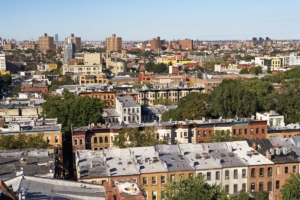New York City has a lot of nicknames – the Big Apple, the City that Never Sleeps, Gotham City – but perhaps we should add one more to the list: the Big Rent Burden.
As a classic rule of thumb, a rent-to-income ratio of 30 percent or lower is considered “affordable,” meaning that renters spend 30 percent or less of their monthly income on rent – freeing up the majority of their income for other costs of living and savings. Even when considering that residents of large cities will typically spend more of their incomes on rent than in less amenity-rich areas, New York is in a league of its own.
The median asking rent in New York City is expected to reach $2,700 in 2015, amounting to a staggering 58.4 percent of median income in the city according to StreetEasy estimates[i]. High rent prices are only half of the picture, though. Stagnant income growth, short supply of rental units, and rapidly increasing rents is making New York City one of the most expensive and challenging rental markets in the country. According to census data, New York City rent prices grew at almost twice the pace of income between 2000 and 2013, meaning that over time rent has taken up a much larger piece of New Yorkers’ incomes.
Like most real estate stories, rent affordability depends greatly on the neighborhood. To get an understanding of what the typical rent burden looks like in each neighborhood, StreetEasy analyzed affordability in each of New York’s neighborhoods across the five boroughs, as measured by a rent-to-income ratio[ii], or the share of a household’s monthly income that is spent on rent, excluding utilities and other costs.
According to our findings, the rent burden is expected to be the greatest in Brooklyn, where the typical new renter will spend 60 percent of their income on rent in 2015, followed by the Bronx (52.0 percent), Manhattan (48.8 percent), Queens (41.4 percent), and Staten Island (30.1 percent).
Supply Shortage Pushes Rents to New Heights
The main culprit in this crisis is a lack of adequate supply of housing. Like many other big cities, New York boasts world-class amenities like parks, restaurants, cultural activities, and sports teams that attract a lot of people to move to the five boroughs. However, development opportunities for new housing in New York is quite limited and expensive in comparison to other cities, causing the supply of rentals to lag far behind demand.
According to recent government figures, the city’s rental vacancy rate is just 3.45 percent[iii]. Simply put, there are more people moving to New York than there are apartments to house them. Competition between renters bids up rent prices and lowers a unit’s time on market. It is quite common to see a line of hopeful tenants at an open house with their checkbook and credit report in hand to seal the deal right away.
The supply deficit is acute in the for-sale market as well. In Manhattan, for example, the number of available homes for sale in the fourth quarter of 2014 was 39 percent below the peak level in 2009. The would-be owners remain renters if they cannot find a home that suits their tastes or budget, putting an extra strain on the already crowded rental market, and further driving up rent prices.
Low-Income Communities are Often the Least Affordable
Affordable rent is often out of reach to those who need it the most. Renters feel the tightest squeeze in areas with relatively low household incomes where rent commands a far greater share of income. In each of the 10 least affordable neighborhoods in 2015 (listed below)[iv], median incomes were well below New York City’s forecasted median ($55,303)[v].The least affordable neighborhood was Manhattanville in Manhattan, where annual rent on newly listed rentals is more than the entire annual income of the typical resident. By contrast, median rent in the five most expensive rental markets (Central Park South, Tribeca, Todt Hill (Staten Island), Flatiron, and DUMBO) accounted for less than half of median household income.

[tableau server=”public.tableausoftware.com” workbook=”rentAffordability2015″ view=”DashboardwithFilters” tabs=”no” toolbar=”” revert=”” refresh=”” linktarget=”” width=”600px” height=”670px”]
Long-term Affordability Rests on Expanding New York’s Rental Supply
With a large pool of eager potential renters fighting for limited units, landlords will continue to raise their asking prices. What can be done to improve affordability in one of the country’s most expensive rental markets? A good place to start is to expand New York’s housing stock. Land use and zoning regulations that restrict the creation of more units distort prices by placing a ceiling on the supply of housing. The rezoning of Williamsburg and Hudson Yards in 2005 and Ozone Park in Queens in 2014 created new housing opportunities for renters and undoubtedly eased some of the demand pressure placed on the city’s rental market.
Of course, more housing does not always mean more affordable housing. The 421-a tax incentive program provides real estate tax exemptions to newly constructed rental buildings that set aside at least 20 percent of total units to low- and moderate-income households. Although buildings with the exemption accounted for more than 150,000 units across the city in 2013, it is entirely voluntary for developers[vi]. Many critics of 421-a claim that the 20 percent set-aside is hardly enough to address the city’s growing affordability problem, and the costly tax exemptions are often characterized as a ‘giveaway’ to developers of luxury condos.
New York City Mayor Bill de Blasio has proposed turning this voluntary set-aside into a mandatory one in six neighborhoods where rezonings are currently being considered: East New York, Flushing West, the Bay Street Corridor in Staten Island, East Harlem, Long Island City, and the Jerome Avenue Corridor in the Bronx. The de Blasio administration has selected areas that face some of the least affordable options today; the rent-to-income ratio in each of these neighborhoods except Flushing West and Bay Street is expected to exceed 50 percent in 2015.
Many of the neighborhoods with the highest rent-to-income ratios, such as Bushwick, Bedford-Stuyvesant and much of the South Bronx, also have the greatest concentration of subsidized housing that will be eligible to opt out of affordability restrictions over the next 10 years. According to a recent analysis by the NYU Furman Center for Real Estate and Urban Policy, more than 58,000 units of subsidized affordable rental housing will be eligible to opt out by 2024[vii]. Without these subsidies, current recipients would face a highly unaffordable rental landscape. The large gap between what is affordable given a neighborhood’s median income and prevailing rent prices highlight the value, and in some cases the necessity, of these housing subsidies in preserving affordability for these communities.
As valuable as income-restricted subsidies are at housing families with the greatest need, they do little to change the underlying forces that make the city’s rental market so unaffordable, namely flagging income growth and lack of available rental units. The key to lowering rent-to-income ratios for all New Yorkers is to expand the city’s housing supply, for it is the growing imbalance between the demand for housing and available inventory that is chiefly responsible for rising rents.
How Did We Do It?
Median asking rent for each neighborhood in 2014 is based on all rental listings on StreetEasy in 2014. Using several years’ worth of rent data, we forecasted median rents in 2015 for each neighborhood with a standard auto-regressive integrated moving average (ARIMA) model. Similarly, we forecasted median household incomes in 2014 and 2015 by using the employment cost index to adjust 2013 ACS 1-year estimates from the U.S. Census. The rent-to-income ratio for each year is the forecasted median annual rent (or actual median annual rent in 2014) divided by the forecasted median household income.
Endnotes
[i] Using several years’ worth of rent data from StreetEasy, we forecasted median rents in 2015 for each neighborhood with a standard auto-regressive integrated moving average (ARIMA) model. See “How Did We Do It?” section of the post for full methodology explanation.
[ii] Neighborhood rent-income ratio is calculated by dividing 2014 median asking rent by 2014 median household income. Median asking rent based on available rental listings on StreetEasy through October.
[iii] 2014 New York City Housing and Vacancy Survey
[iv] Neighborhoods with at least 10 rental listings in 2014 were included in this analysis.
[v] 2014 median household income based on 2012 ACS 5-year estimate and recent employment cost index trends.
[vi] New York City Department of Finance, http://www.nyc.gov/html/dof/html/property/421a.shtml
[vii] http://furmancenter.org/thestoop/entry/new-york-citys-opt-out-outlook









